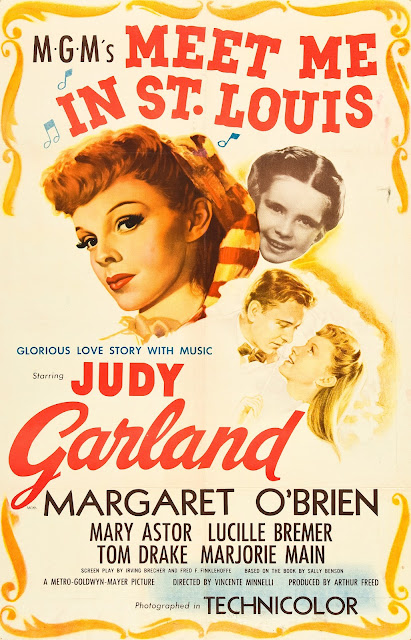Format: TCM
Viewing: Second
Decade: 1940's
Director: Vincente Minnelli
My allergies were destroying me, so we agreed to just put on something light and simple. I didn't realize Jamie had never seen this one, so maybe it was a good choice? She never said much about what she thought about it.
Meet Me In St. Louis (1944) is only barely a Christmas film. It follows about a year with a family in St. Louis over 1903-04, in a world just around the corner from that which inspired Walt Disney's Main Street USA in the Disney Parks. That's not an exaggeration - Disney did base Main Street on the small town of Marceline, Missouri, where he would have lived about 4 years after the events of the film as a young child (Disney born 1901).
The film boasts a name cast, headlined by Judy Garland, and as a product of wartime filmmaking, the cast skews female-centric and features non-draft eligible gentlemen in support roles. Mary Astor seems cast too-young as the patient matriarch, paired with Leon Ames as the father. Lucille Bremer appears in her first (of like 10) role, Margaret O'Brien as arguably the #2 lead in the film at 7 years old, Harry Davenport as "Grandpa". Joan Caroll, who plays Patsy in Bells of St. Mary's is another sister.
I imagine seeing this Gilded-Age America in the relative Mid-West with wholesome problems was a very good idea for a country still in the thick of war. Home and hearth were at stake, and something steeped in a particular flavor of naivete and nostalgia before the nation was really working on a global stage and figuring itself out like an adolescent was welcome.
Garland really is very good here. She seems dialed in, even if she's playing someone considerably younger than her age (I think she's 22 playing 16 or 17). And as this is something of an ensemble picture, she's generous with her costars, both the newbie Bremer (who is just fine) and O'Brien, especially, with whom she seems to have worked out quite the partnership.
The performances are all as good as you could hope for, especially O'Brien, whose precociousness is never twee and she manages a level of natural performance (especially for a kid!) in a film that is all artifice, from the sets to the structure and songs and carefully crafted nostalgia, to Judy Garland's auburn tresses. In many ways, she grounds the film, making the reality of the change coming for the family have some weight when she lashes out.
This isn't my favorite film, but it is a stunning piece of Hollywood's design sense and terrific songwriting. This is where we got both "The Trolley Song" and "Have Yourself a Merry Little Christmas", which was in part a product of Garland refusing the original lyrics, which promised death and tragedy. And there's definitely something to be said for how we're still singing songs that rose to prominence during WWII, including "White Christmas" and "I'll Be Home For Christmas". If it's sad and longing for better days - it might be a WWII tune.
The entire build from the post-dance sequence/ proposal scene through Have Yourself a Merry Little Christmas to the proclamation scene by Leon Ames is some terrifically good filmmaking. Minnelli's sense for the dramatic and comedic, and the team he had to light and shoot this thing was incredible. (There's a shot leading into the Christmas Ball that is absolutely bananas, passing from a darkened exterior to a brightly lit, swirling interior - through glass - and into the room. I have to assume from a frame of glass crossing the screen an entire wall of the set was moved aside to achieve it, but have no idea.) Even if it's not your thing, it's worth *looking at* to see what they did.
And, that sequence makes this movie Christmassy as hell.


No comments:
Post a Comment
Keep it friendly. Comment moderation is now on. We are not currently able to take Anonymous comments. I apologize.